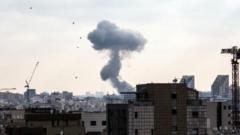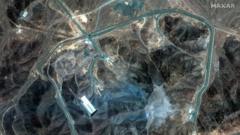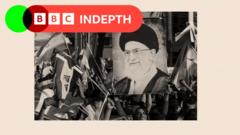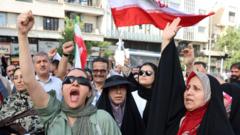Iran faces a critical juncture, deliberating its potential strategies in the wake of recent US airstrikes, which threaten both regional stability and its domestic standing.
**Iran's Dilemma: Assessing Potential Retaliation Options Following US Airstrikes**

**Iran's Dilemma: Assessing Potential Retaliation Options Following US Airstrikes**
As tensions escalate, Iran weighs its response options after US attacks on its nuclear facilities.
Iran is grappling with intense pressure to respond decisively against US airstrikes that targeted its nuclear facilities, an act that has drawn ire and calls for retribution from its leadership. The rhetoric from Tehran underscores the expectation of "everlasting consequences," but the decision-making process is fraught with danger and complexity.
Within Iran's power circles, strategic discussions are unfolding regarding whether to escalate retaliation against US interests directly or heed US President Donald Trump's call for negotiations that would entail major concessions relating to its nuclear program. Key figures in Iran's military and intelligence communities are acutely aware of their precarious positioning, concerned about the potential risk of targeted airstrikes from Israel as internal trust fractures under pressure.
The strategic paths open to Iran are treacherous. The immediate option involves launching a swift counterattack, an act fueled by continued humiliation from Israel and the US. Although Iran retains a sizeable missile arsenal, consisting of about half of the original stockpiles, this could incite a drastic regional conflict. Targets such as the US Navy’s Fifth Fleet in Bahrain loom large, yet striking there could stir further complications with neighboring Gulf states.
The more plausible tactic might involve utilizing proxy forces in Iraq or Syria against US bases, as seen during previous skirmishes. Iran could implement unconventional methods, including 'swarm attacks' deploying drones and fast boats against US naval vessels, or galvanizing allied militia groups like the Houthis to disrupt maritime trade flows.
Alternatively, Iran might opt for a more calculated approach by delaying any military response until the atmosphere is less charged, potentially allowing for covert operations aimed at US military or diplomatic assets. This necessitates a balancing act; while a surprise strategy could inflict damage, it also risks provoking renewed US military action.
Another avenue could involve exercising restraint altogether. Diplomacy emerges as a cautious alternative, although it would require Iran to navigate stringent US preconditions, including relinquishing its uranium enrichment. However, declining to retaliate risks projecting weakness to Iranian constituents who expect a forceful repudiation against perceived aggressions.
In navigating these perilous waters, Iran weighs the consequences delicately—any miscalculation could not only undermine its regional tact but threaten its regime's very stability in the face of external pressures and internal dissent.
Within Iran's power circles, strategic discussions are unfolding regarding whether to escalate retaliation against US interests directly or heed US President Donald Trump's call for negotiations that would entail major concessions relating to its nuclear program. Key figures in Iran's military and intelligence communities are acutely aware of their precarious positioning, concerned about the potential risk of targeted airstrikes from Israel as internal trust fractures under pressure.
The strategic paths open to Iran are treacherous. The immediate option involves launching a swift counterattack, an act fueled by continued humiliation from Israel and the US. Although Iran retains a sizeable missile arsenal, consisting of about half of the original stockpiles, this could incite a drastic regional conflict. Targets such as the US Navy’s Fifth Fleet in Bahrain loom large, yet striking there could stir further complications with neighboring Gulf states.
The more plausible tactic might involve utilizing proxy forces in Iraq or Syria against US bases, as seen during previous skirmishes. Iran could implement unconventional methods, including 'swarm attacks' deploying drones and fast boats against US naval vessels, or galvanizing allied militia groups like the Houthis to disrupt maritime trade flows.
Alternatively, Iran might opt for a more calculated approach by delaying any military response until the atmosphere is less charged, potentially allowing for covert operations aimed at US military or diplomatic assets. This necessitates a balancing act; while a surprise strategy could inflict damage, it also risks provoking renewed US military action.
Another avenue could involve exercising restraint altogether. Diplomacy emerges as a cautious alternative, although it would require Iran to navigate stringent US preconditions, including relinquishing its uranium enrichment. However, declining to retaliate risks projecting weakness to Iranian constituents who expect a forceful repudiation against perceived aggressions.
In navigating these perilous waters, Iran weighs the consequences delicately—any miscalculation could not only undermine its regional tact but threaten its regime's very stability in the face of external pressures and internal dissent.























